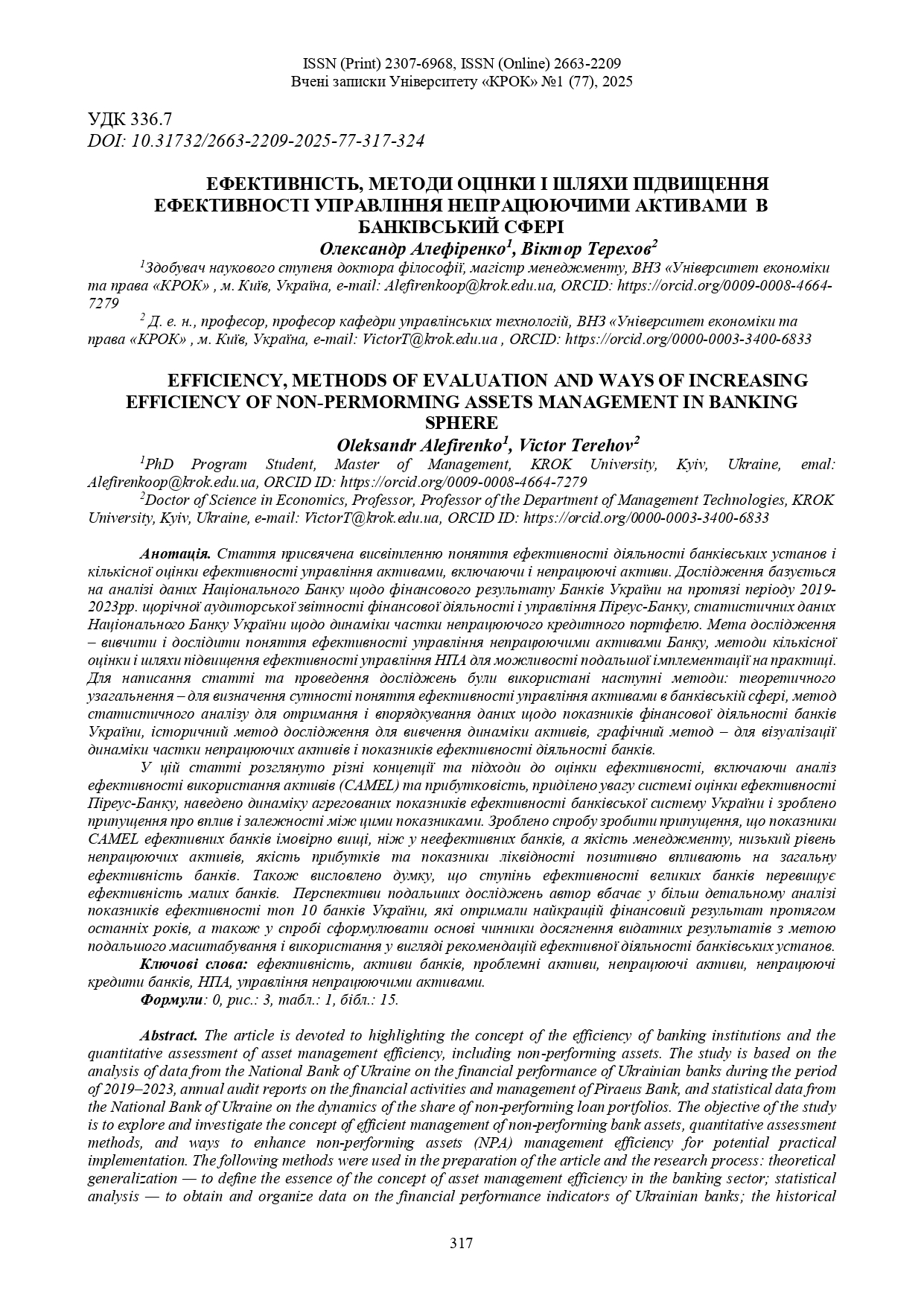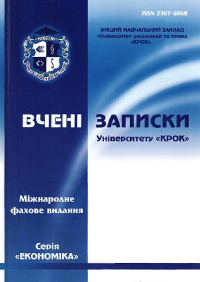EFFICIENCY, METHODS OF EVALUATION AND WAYS OF INCREASING EFFICIENCY OF NON-PERMORMING ASSETS MANAGEMENT IN BANKING SPHERE
DOI:
https://doi.org/10.31732/2663-2209-2025-77-317-324Keywords:
efficiency, assets of banks, non-performing assets, non-performing bank loans, NPA, management of non-performing assetsAbstract
The article is devoted to highlighting the concept of the efficiency of banking institutions and the quantitative assessment of asset management efficiency, including non-performing assets. The study is based on the analysis of data from the National Bank of Ukraine on the financial performance of Ukrainian banks during the period of 2019–2023, annual audit reports on the financial activities and management of Piraeus Bank, and statistical data from the National Bank of Ukraine on the dynamics of the share of non-performing loan portfolios. The objective of the study is to explore and investigate the concept of efficient management of non-performing bank assets, quantitative assessment methods, and ways to enhance non-performing assets (NPA) management efficiency for potential practical implementation. The following methods were used in the preparation of the article and the research process: theoretical generalization — to define the essence of the concept of asset management efficiency in the banking sector; statistical analysis — to obtain and organize data on the financial performance indicators of Ukrainian banks; the historical research method — to study the dynamics of assets; and the graphical method — to visualize the dynamics of the share of non-performing assets and indicators of banking performance efficiency. This article examines various concepts and approaches to efficiency evaluation, including the analysis of asset utilization efficiency (CAMEL) and profitability. Special attention is given to the efficiency evaluation system of Piraeus Bank, presenting the dynamics of aggregated efficiency indicators of the Ukrainian banking system and making assumptions about the impact and interdependence of these indicators. An attempt is made to hypothesize that the CAMEL indicators of efficient banks are likely higher than those of inefficient banks, and that the quality of management, low levels of non-performing assets, profitability quality, and liquidity indicators positively influence the overall efficiency of banks. Furthermore, it is suggested that the efficiency of large banks exceeds that of small banks. The author sees the prospects for further research in a more detailed analysis of the efficiency indicators of the top 10 Ukrainian banks, which have achieved the best financial results in recent years, as well as in the attempt to formulate the key factors for achieving outstanding results with the aim of further scaling and using them as recommendations for the effective operation of banking institutions.
Downloads
References
Акціонерне товариство «ПІРЕУС БАНК МКБ». (2024). Звіт про управління, фінансова звітність та звіт незалежних аудиторів за рік, який закінчився 31 грудня 2023 року. Retrieved from
Abdelmoneim, Z., & Yasser, M. (2023). The impact of bank performance and economic growth on bank profitability: CAMEL model application in middle-income countries. Banks and Bank Systems, 18(3), 205-220. doi: 10.21511/bbs.18(3).2023.17
Al-Sadi, A, & Al-Mamouri, A. (2022). The impact of asset management on achieving bank profitability. Periodicals of Engineering and Natural Sciences, 10(5). Retrieved from
Altavilla, C., Begenau, J., Burlon, L., & Maruhn, F. (2025). Determinants of bank performance: Evidence from replicating portfolios. European Central Bank. Retrieved from
https://www.ecb.europa.eu/pub/pdf/scpwps/ecb.wp2937~7e22f4dc25.en.pdf
Belhaj, S., & Mateus, C. (2016). Corporate governance impact on bank performance: Evidence from Europe. Corporate Ownership and Control. doi: 10.22495/cocv13i4c4p8
Buch, C. (2024). Bank profitability: A mirror of the past, creating a vision for the future. European Central Bank. Retrieved from
Drucker, P. F. (1963). Managing for business effectiveness. Harvard Business Review. Retrieved from
https://hbr.org/1963/05/managing-for-business-effectiveness
European Central Bank. (n.d.). Retrieved from
https://www.ecb.europa.eu/home/html/index.en.html
Jain, A., Pollini, P., & Hardy, V. (2024). Regional bank performance: What factors make the top banks different. PwC US. Retrieved from
https://www.pwc.com/us/en/industries/financial-services/library/regional-bank-performance.html
Kweh, Q. L., Lu, W. M., Tone, K., & Liu, H. M. (2024). Evaluating the resource management and profitability efficiencies of US commercial banks from a dynamic network perspective. Financial innovation 10(19). doi: 10.1186/s40854-023-00531-0
Мудра, Р. Р. (2018). Ефективність функціонування банків України на ринку банківських продуктів і послуг. Економіка і суспільство, 17 (85). doi: 10.32782/2524-0072/2018-17-85
Національний банк України. (n.d.). Retrieved from
Novickytėa, L., & Petraitytėa, I. (2013). Assessment of banks asset and liability management: Problems and perspectives (case of Lithuania). Procedia - Social and Behavioral Sciences, (110). doi: 10.1016/j.sbspro.2013.12.955
Pastor, J. M. (1998). Efficiency and risk management in banking firms: A method to decompose risk. Working Papers, (1998-10). Retrieved from
https://typeset.io/pdf/efficiency-and-risk-management-in-banking-firms-a-method-to-4eefstckks.pdf
Святенко, С. В., & Потапчук, А. В. (2020). Оцінка ефективності управління активами і пасивами АТ «КБ «ПРИВАТБАНК». Східна Європа: Економіка, бізнес та управління, 1(24). doi: 10.32782/easterneurope.24-34

Downloads
Published
How to Cite
Issue
Section
License

This work is licensed under a Creative Commons Attribution-NonCommercial 4.0 International License.

